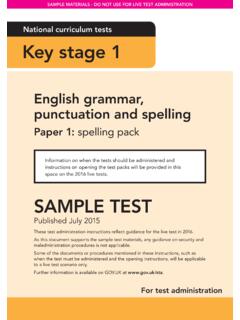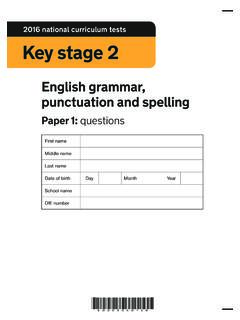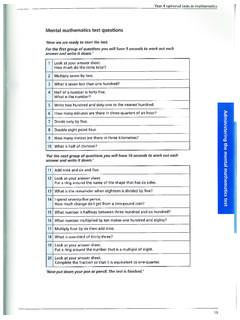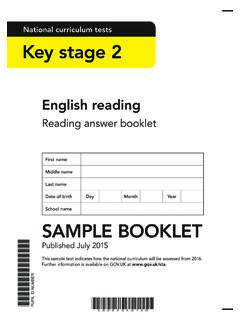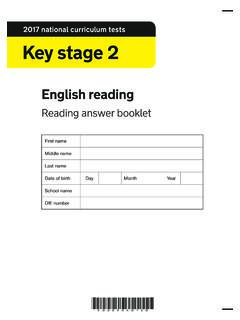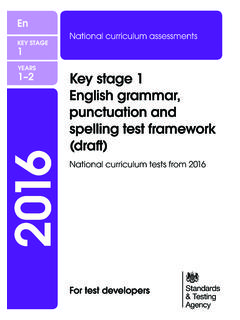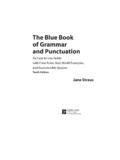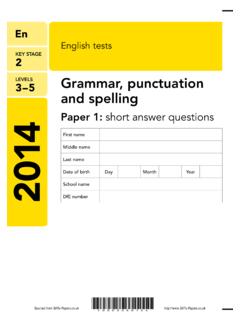Transcription of English grammar, punctuation and spelling - SATs Papers …
1 SAMPLE MATERIALS - DO NOT USE FOR LIVE TEST ADMINISTRATIONN ational curriculum testsKey stage 1 For test administrationEnglish grammar , punctuation and spellingPaper 2: questions packSAMPLE TEST Published July 2015 These test administration instructions reflect guidance for the live test in this document supports the sample test materials, any guidance on security and maladministration procedures is not applicable. Some of the documents or procedures mentioned in these instructions, such as when the test must be administered and the opening instructions, will be applicable to a live test scenario information is available on at w w /sta. Information on when the tests should be administered and instructions on opening the test packs will be provided in this space on the 2016 live MATERIALS - DO NOT USE FOR LIVE TEST ADMINISTRATION2016 Key stage 1 English grammar , punctuation and spelling sample test Paper 2: questionsThe key stage 1 English grammar , punctuation and spelling sample test consists of 2 Papers .
2 The Papers must be administered in order. Pupils may have a break between the Papers . However, test packs must not be opened until the pupils are in the test room ready to complete the 2: questionsThe following information explains how to administer key stage 1 English grammar , punctuation and spelling sample test Paper 2: questions. If you have any questions, you should check with your headteacher or key stage 1 test co-ordinator before you administer the test. Please make sure you follow these instructions correctly to ensure that the test is properly This component consists of a single test paper. Pupils will have approximately 20 minutes to complete the questions in the test paper (not strictly timed). It is at your discretion to choose when or if pupil(s) require a break during the test or whether, if appropriate, to stop the test will need the equipment below: a blue / black pen or a dark pencil a rubber (optional). If rubbers are not provided, you should tell pupils that they may cross out any answers they wish to will not be allowed the equipment below: dictionaries, electronic spell checkers or bilingual word must ensure that nothing you say or do during the test could be interpreted as giving pupils an may explain or rephrase a question provided you do not give away subject-specific information.
3 For example, if a question asks to insert a pair of commas , insert may be explained but not commas . You must not give alternative explanations: explain commands as instructions or name punctuation . The notes for readers in the English grammar , punctuation and spelling test gives examples of how to read particular types of question in Paper 2: examples below illustrate how to deal with some common situations. Q. I don t understand the question. A. Read the question again and underline key words that tell you what to do. Q. What does comma mean? A. I can t tell you, but think hard and try to remember. We can talk about it after the any context or words related to a question are unfamiliar to a pupil, you may show them related objects or pictures, or describe the related context. Before the test begins Review the list of pupils with any particular individual needs: pupils who may need a scribe, a reader or a transcript made at the end of the test.
4 Ensure that you know how to administer any access arrangements correctly. Check that there are enough administrators to maintain supervision and support for the test. You should consider the possibility of at least 1 test administrator needing to leave the room with a pupil. Read the notes for readers in the English grammar , punctuation and spelling test. Ensure that you understand how to deal with issues during the MATERIALS - DO NOT USE FOR LIVE TEST ADMINISTRATIONHow to deal with issues during the testIt is impossible to plan for every scenario. Whatever action you take, pupil safety must always be your first consideration. In the following circumstances, you will need to stop the test either for an individual pupil or for the whole cohort: test Papers are incorrectly collated or the print is illegible an incorrect test has been administered a fire alarm goes off a pupil is unwell a pupil needs to leave the test room during the tests a pupil is caught you need to stop the test: make a note of the time make sure pupils are kept under test conditions and that they are supervised if they have to leave the room, ensure they don t talk about the test speak to your test co-ordinator or a senior member of staff for advice on what to do should brief your headteacher on how the incident was dealt with, once the test is to do at the start of the test Check that seating is appropriately spaced and that no pupil can see another pupil s test paper.
5 Ensure that each pupil has a copy of Paper 2: questions. What to say at the start of the testIt is important to brief pupils fully at the start of each test. You should use these instructions to introduce Paper 2: questions. The wording of these instructions can be adapted, provided the meaning is retained. You should use words and phrases familiar to the pupils, and you may repeat them as many times as necessary to ensure that the pupils understand what to to the pupils that this is the key stage 1 English grammar , punctuation and spelling test Paper 2: questions. Explain that the test will take around 20 minutes, but is not strictly the pupils that they should have Paper 2: questions test paper in front of the pupils to write their names on the front of their answer the pupils that they will need a blue / black pen or dark pencil and rubber (optional) for this to the pupils that, if they want to change an answer, they should rub it out or put a line through the response they don t want to be the pupils to open their answer booklets at page 3.
6 Explain that there are two practice questions and that you will do the practice questions together with MATERIALS - DO NOT USE FOR LIVE TEST ADMINISTRATIONWhat to say at the start of the test (continued) Practice question a Read the question to the the word that completes the sentence. Then read the were ___(blank)___ on our read the words out individually. Don t read them as part of the pupils the opportunity to answer the question in their booklet. If any pupil is not sure what to do, explain what they need to do to answer the question b Read the question to the one word on the line below to complete the sentence in the past tense. Then read the ___(blank)___ to Scotland during the school pupils the opportunity to answer the question in their to the pupils that there will also be other types of question. If the pupils are unsure how to answer tell them that they should ask. Explain to the pupils that when the test starts they should try to answer the questions by the pupils to try to answer all of the questions.
7 Explain that if they can t answer a question, they should move on to the next one and come back to it the pupils to read each question carefully so that they know what it is that, if they want to change an answer, they should rub it out or put a line through the response they don t want to be the pupils to check their work that, if they have any questions during the test, they should put their hand up and wait for someone to come over to them, but that you can t help them answer any of the test the pupils that they must not talk to each the pupils if they have any questions they want to ask you now. Start the to do at the end of the testIf any pupil needs a transcript, complete it with the pupil at the end of the test under test conditions. Particular care should be taken to ensure accurate transcriptions are made and the pupil s answers, including spelling , are not corrected or amended. Marking the testsUse the key stage 1 sample test mark schemes to mark the test, following both the general guidance and any specific guidance for each question.
8 SAMPLE MATERIALS - DO NOT USE FOR LIVE TEST ADMINISTRATION2016 key stage 1 sample English grammar , punctuation and spelling Paper 2: questions pack Electronic version product code: STA/15/7354/PKe ISBN: 978-1-78315-895-9 Crown copyright and Crown information 2015 Re-use of Crown copyright and Crown information in test materials Subject to the exceptions listed below, the test materials on this website are Crown copyright or Crown information and you may re-use them (not including logos) free of charge in any format or medium in accordance with the terms of the Open Government Licence which can be found on the National Archives website and accessed via the following link: When you use this information under the Open Government Licence , you should include the following attribution: Contains public sector information licensed under the Open Government Licence and where possible provide a link to the we have identified any third-party copyright information you will need to obtain permission from the copyright holders concerned.
